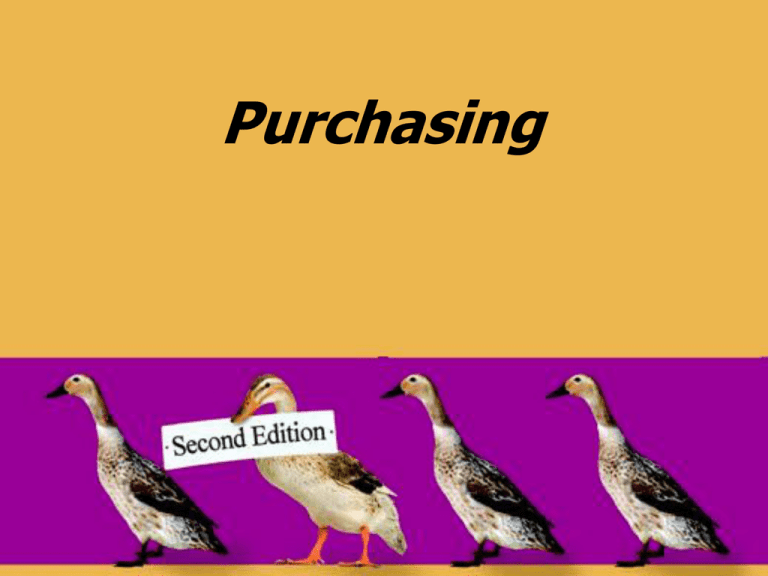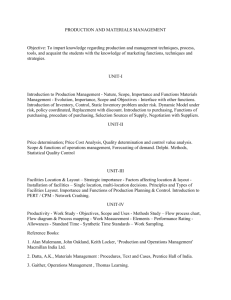
Purchasing
Chapter Objectives
Be able to:
Make a strong case for why purchasing is a
critical part of a firm’s supply chain strategy.
Identify and describe the various steps of the
purchasing process, and discuss how this
process will vary according to the type of good
or service being purchased.
Explain why spend analysis is important and
perform a simple spend analysis.
© 2008 Pearson Prentice Hall --- Introduction to Operations and Supply
Chain Management, 2/e --- Bozarth and Handfield, ISBN: 0131791036
Chapter 11, Slide 2
Introduction
• Why Purchasing is Critical
• The Purchasing Process
• Spend Analysis
© 2008 Pearson Prentice Hall --- Introduction to Operations and Supply
Chain Management, 2/e --- Bozarth and Handfield, ISBN: 0131791036
Chapter 11, Slide 3
Focus
Sourcing decisions and purchasing activities serve to
link a company with its supply chain partners
• Sourcing decisions – (discussed in Chapter 10)
High level, often strategic decisions regarding which products or
services will be provided internally and which will be provided by
external supply-chain partners
• Purchasing –
The activities associated with identifying needs, locating and
selecting suppliers, negotiating terms, and following up to ensure
supplier performance
© 2008 Pearson Prentice Hall --- Introduction to Operations and Supply
Chain Management, 2/e --- Bozarth and Handfield, ISBN: 0131791036
Chapter 11, Slide 4
Why Purchasing
is Critical – I
The Changing Global Competitive
Landscape
• To compete globally, you need to
purchase globally
• Global purchasing efforts are
supported by advances in information
systems
© 2008 Pearson Prentice Hall --- Introduction to Operations and Supply
Chain Management, 2/e --- Bozarth and Handfield, ISBN: 0131791036
Chapter 11, Slide 5
Why Purchasing
is Critical – II
Financial Impact
• For the average manufacturer, 52.5%
of the value of shipments comes from
materials
• Purchasing represents a major
opportunity to increase profitability
© 2008 Pearson Prentice Hall --- Introduction to Operations and Supply
Chain Management, 2/e --- Bozarth and Handfield, ISBN: 0131791036
Chapter 11, Slide 6
Why Purchasing is Critical
Financial Impact - I
Lowe’s Company
Earnings and Expenses
Sales
COGS
Pretax earnings
$26,491
$18,465
$2,359
Selected Balance Sheet Items
Merchandise inventory
Total assets
$3,968
$16,109
© 2008 Pearson Prentice Hall --- Introduction to Operations and Supply
Chain Management, 2/e --- Bozarth and Handfield, ISBN: 0131791036
Every dollar saved in
purchasing for
increases pretax profit
by one dollar
Every dollar saved
in purchasing
inventory
lowers total assets
by one dollar
Chapter 11, Slide 7
Why Purchasing is Critical
Financial Impact - II
3% purchasing reduction in COGS
Earnings and Expenses
Sales
COGS
Pretax earnings
Current
With 3% saving
$26,491
$18,465
$2,359
$26,491
$17,911
$2,913
Selected Balance Sheet Items
Merchandise inventory $3,968
Total assets
$16,109
$3,849
$15,990
© 2008 Pearson Prentice Hall --- Introduction to Operations and Supply
Chain Management, 2/e --- Bozarth and Handfield, ISBN: 0131791036
Pretax earnings
increase by
$554 (23.4%)
ROA increases
from 14.6% to
18.2%
Chapter 11, Slide 8
Why Purchasing
is Critical – III
Performance Impact
• Quality
• Delivery
• Ability to exploit new technologies
© 2008 Pearson Prentice Hall --- Introduction to Operations and Supply
Chain Management, 2/e --- Bozarth and Handfield, ISBN: 0131791036
Chapter 11, Slide 9
Why Purchasing is Critical
Performance Impact - I
Sourcing dialysis machine valves
Cost per
valve
% good
Delivery
lead time
Supplier A
$10
Supplier B
$2
99.8%
95%
Overnight
delivery
1 day to
3 weeks
© 2008 Pearson Prentice Hall --- Introduction to Operations and Supply
Chain Management, 2/e --- Bozarth and Handfield, ISBN: 0131791036
Chapter 11, Slide 10
Why Purchasing is Critical
Performance Impact - II
Effect of defective dialysis machine
valves
•
•
•
•
Interruption in patient treatment
Rescheduling difficulties
Reduction in the effective capacity for dialysis
Possible medical emergencies
Estimated cost of a failed valve = $1,000
© 2008 Pearson Prentice Hall --- Introduction to Operations and Supply
Chain Management, 2/e --- Bozarth and Handfield, ISBN: 0131791036
Chapter 11, Slide 11
Why Purchasing is Critical
Performance Impact - III
Sourcing 50 dialysis machine valves
(Total Costs)
Supplier A
Valve costs
Failure
costs
Backup
inventory
Total costs
Supplier B
50 x $10 = $500
50 x $2 = $100
0.2% x 50 valves x
$1,000 = $100
5% x 50 valves x
$1,000 = $2,500
1 valve x $10 = $10
3 valves x $2 = $6
$610
© 2008 Pearson Prentice Hall --- Introduction to Operations and Supply
Chain Management, 2/e --- Bozarth and Handfield, ISBN: 0131791036
$2,606
Chapter 11, Slide 12
The Purchasing Process
Needs identification
Description
No
Supplier identification
and evaluation
Is there a preferred supplier?
Yes
Supplier selection & contracting
Purchase order preparation
Follow up and expediting
Receipt and inspection
Order
cycle
Settlement & payments
Records maintenance
© 2008 Pearson Prentice Hall --- Introduction to Operations and Supply
Chain Management, 2/e --- Bozarth and Handfield, ISBN: 0131791036
Chapter 11, Slide 13
The Purchasing Process
Needs Identification
Needs identification
• Purchase requisition –
An internal document completed by a user that
informs purchasing of a specific need
• Reorder point system –
A method used to initiate the purchase of
routine items. Typically, each item has a
predetermined order point and order quantity
• Statement of Work/Scope of
Work (SOW) –
Terms and conditions for a purchased service.
Includes how supplier will be evaluated
© 2008 Pearson Prentice Hall --- Introduction to Operations and Supply
Chain Management, 2/e --- Bozarth and Handfield, ISBN: 0131791036
Chapter 11, Slide 14
The Purchasing Process
Description
Description
The communication of a user’s needs
to potential suppliers in the most
efficient and accurate way possible
• Description by market grade/industry standard
• Description by brand
• Description by specification
• Description by performance characteristics
• Description by prototypes or samples
© 2008 Pearson Prentice Hall --- Introduction to Operations and Supply
Chain Management, 2/e --- Bozarth and Handfield, ISBN: 0131791036
Chapter 11, Slide 15
The Purchasing Process
Supplier Identification and Evaluation - I
Supplier identification
and evaluation
The amount of effort increases as:
• The complexity of the product
or service increases
• The amount of money that is
committed increases
• The length of the proposed
buyer-supplier relationship
increases
© 2008 Pearson Prentice Hall --- Introduction to Operations and Supply
Chain Management, 2/e --- Bozarth and Handfield, ISBN: 0131791036
Chapter 11, Slide 16
The Purchasing Process
Supplier Identification and Evaluation - II
Supplier identification
and evaluation
Criteria for supplier
assessment:
• Process and design capabilities
• Management capability
• Financial condition and cost
structures
• Planning and control systems
• Environmental regulation
compliance
• Longer-term relationship potential
© 2008 Pearson Prentice Hall --- Introduction to Operations and Supply
Chain Management, 2/e --- Bozarth and Handfield, ISBN: 0131791036
Chapter 11, Slide 17
The Purchasing Process
Supplier Selection - I
• Competitive bidding
Supplier selection & contracting
• Negotiation
• Fixed-price contracts
• Cost-based contracts
© 2008 Pearson Prentice Hall --- Introduction to Operations and Supply
Chain Management, 2/e --- Bozarth and Handfield, ISBN: 0131791036
Chapter 11, Slide 18
The Purchasing Process
Supplier Selection - II
Preferred supplier
Supplier selection & contracting
A supplier that has
demonstrated its performance
capabilities through previous
purchase contracts and
therefore receives preference
during the supplier selection
process
© 2008 Pearson Prentice Hall --- Introduction to Operations and Supply
Chain Management, 2/e --- Bozarth and Handfield, ISBN: 0131791036
Chapter 11, Slide 19
The Purchasing Process
Supplier Selection - III
Competitive bidding is most
effective when:
Supplier selection & contracting
• The buying firm can provide
qualified suppliers with clear
descriptions of the items or
services
• Volume is high enough to justify
the cost and effort
• The firm does not have a
preferred supplier
© 2008 Pearson Prentice Hall --- Introduction to Operations and Supply
Chain Management, 2/e --- Bozarth and Handfield, ISBN: 0131791036
Chapter 11, Slide 20
The Purchasing Process
Supplier Selection - IV
Negotiation is most effective when:
Supplier selection & contracting
• The item is new or technically complex
with only vague specifications
• The purchase requires agreement about a
wide range of performance factors
• The supplier must participate in the
development effort
• The supplier cannot determine risks
and costs without input from the buyer
© 2008 Pearson Prentice Hall --- Introduction to Operations and Supply
Chain Management, 2/e --- Bozarth and Handfield, ISBN: 0131791036
Chapter 11, Slide 21
The Purchasing Process
Supplier Selection - V
Contracting is most effective when:
• There is a large amount of money involved
Supplier selection & contracting
• The business needs specific requirements
that need to be put into writing such as
quality levels, delivery times
Two basic types of contracts:
• Fixed-price – price does not change for life
of contract
• Cost-based – price tied to cost of selected
key input or economic factor
© 2008 Pearson Prentice Hall --- Introduction to Operations and Supply
Chain Management, 2/e --- Bozarth and Handfield, ISBN: 0131791036
Chapter 11, Slide 22
The Purchasing Process
The Order Cycle
• Purchase order preparation
Purchase order preparation
Follow-up and expediting
Receipt and inspection
Settlement and payment
Records maintenance
74% of firms currently have electronic
data interchange (EDI) with some part of
their supply base
• Follow-up and expediting
• Receipt and inspection
• Invoice clearance and payment
• Records maintenance
© 2008 Pearson Prentice Hall --- Introduction to Operations and Supply
Chain Management, 2/e --- Bozarth and Handfield, ISBN: 0131791036
Chapter 11, Slide 23
Spend Analysis
Answers the questions:
• What are the top 10 commodities by
annual spend? (provides priority)*
• Which commodities have the most
suppliers? (helps reduce purchasing load)
• Which commodities have the lowest spend
per supplier? (if also among top 10, potential for
savings)
* Similar to ABC analysis to identify critical inventory items based on cost and quantity
© 2008 Pearson Prentice Hall --- Introduction to Operations and Supply
Chain Management, 2/e --- Bozarth and Handfield, ISBN: 0131791036
Chapter 11, Slide 24
Typical Answer to First
Question
© 2008 Pearson Prentice Hall --- Introduction to Operations and Supply
Chain Management, 2/e --- Bozarth and Handfield, ISBN: 0131791036
Chapter 11, Slide 25
Case Study in Purchasing
The ABCs of Spend Analysis






